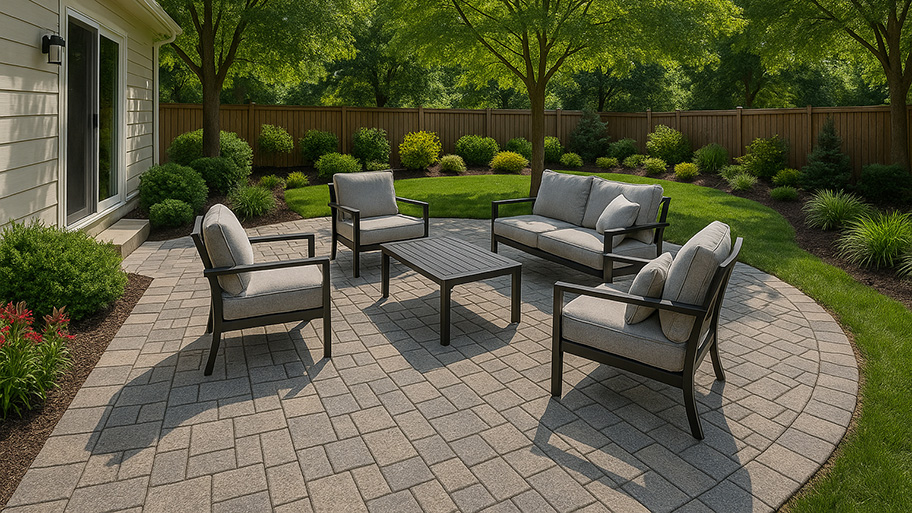
Thinking about installing concrete or brick pavers for a walkway or patio? Learn the cost of interlocking pavers in this informational guide.
Cutting concrete pavers can be a simple DIY project with the right precautions and tools


Whether you’re installing a new paver patio or replacing existing pavers, chances are you’ll need to know how to cut concrete pavers to fit into your design. Cutting concrete pavers can be dangerous and challenging, but with the right tools, anyone can get the job done quickly and safely. In this guide, we’ll discuss all of your options for cutting your concrete pavers, from super simple and inexpensive to more complicated options for getting the job done more quickly.
Concrete pavers are designed to fit together nicely to produce an aesthetically pleasing—and usually square—design. You can use whole pavers for the bulk of your paver patio project.
However, when you get to the edges, there’s a good chance you’ll need to cut pieces if the design doesn’t allow for full pavers to run up to your borders. You might also need to know how to cut concrete pavers if you have to work around pergola posts, built-in benches, or other items that could interrupt the otherwise square pattern of the pavers.
Before cutting pavers, be aware of the necessary safety precautions, the chance of mistakes, and finishing off the edge of your patio.
Above all else, keep yourself safe when cutting pavers. We strongly recommend eye protection, as pieces of the paver can shoot up toward your face while you work. We also recommend hearing protection, especially if you’re using loud power tools.
Finally, plan to wear a respirator while you work. Concrete contains crystalline silica, which can become airborne when cutting pavers. Breathing concrete dust in for short periods may not cause any issues, but it’s better to be safe than sorry. Long-term exposure is dangerous, according to the (CDC).
Whether you’re a beginner DIYer or seasoned professional, concrete pavers sometimes won’t act as you expect them to. Small fissures or weaknesses in pavers can cause them to crack while cutting them, rendering that paver useless.
We recommend you purchase more pavers than you need to account for unexpected breaks. Buying around 10% more than you need is an excellent place to start. You can always return the extras when you’re done.
If you’re cutting pavers, chances are you’re working on the edge of your paver patio. Since you’re using individual pavers instead of a concrete form, you’ll probably want to install edging using paver staples to prevent them from shifting.
Knowing how to cut paver staples is useful if you need to work around rocks, roots, or other obstructions. You can use heavy-duty wire cutters or bolt cutters to get the job done.

There are a few ways to cut concrete pavers, including one option that requires no power tools and several that do. We’ll discuss how to cut pavers in the following sections using three different methods.
If you aren’t comfortable using power tools or don't have access to them, you can use a hammer and chisel to cut your pavers. This method is suitable for just about any DIYer, although it does come with the highest risk of broken pavers.
Using a piece of chalk, mark your cut line on the paver.
Hold the chisel at a 90-degree angle to the surface of the paver and, following the guideline, hammer in small indentations across the entire cut line.
Make a few passes over the line, gradually increasing the force you use each time. Your indentation should be a little over 1/8 inch deep when you’re done.
Once you reach the required depth, place the chisel in the center of the guideline and hit it hard with the hammer. Continue until the paver breaks along the line. Alternatively, you can hang the cut-off side over an edge and hit it with a mallet to break the paver along the guideline.

If you’ve worked with power tools in the past and are comfortable using them, an angle grinder will make quick, clean work of cutting concrete pavers. Just be sure to install a masonry blade. We recommend a diamond blade for longevity, but an abrasive blade is a more affordable option that also works well.
Mark your desired cut line using chalk or a permanent marker.
Turn on the angle grinder and slowly make a very shallow pass over the guideline with the blade.
Make another pass, going a little deeper than you did on the previous one.
Continue until you have a cut between 1/8 inch and 1/4 inch deep. To reduce the risk of unexpected breaks in your pavers, you can go down to about 1/2 inch before moving on, although this will take more time and wear down your blade more quickly.
While you make these passes, it’s a good idea to let the blade run in open air for a few seconds after each one. This will help the blade cool off naturally.
Place a chisel in the center of the cut line and hit it hard with a hammer to finish the cut through the paver.

A circular saw is another power tool option for cutting concrete pavers, but it’s a little less user-friendly than an angle grinder. Before you begin, make sure you install a masonry blade.
Mark your cut line with chalk or a permanent marker.
With the saw off, set your blade depth so your first pass will be no deeper than the depth of the blades. This is usually less than 1/2 inch. You can also set it to a depth of around 1/4 inch to make two passes, if you prefer.
Secure the paver you need to cut to your work surface. You might need to use clamps for this. If you’re working with small pavers, a circular saw might not be the best option, as the plate on your saw may collide with the clamps.
Turn the saw on and slowly move the blade through the paver, following the guideline. We recommend letting the saw run in the open air every few inches to help it cool down to a safe temperature.
Once you complete the pass, place a chisel in the middle of the cut and hit it with a hammer to complete it.
Choosing the right tool to cut your pavers is critical for both your safety and the project's success. We'll include some tips below to help you decide which option is right for you.
You must feel safe and confident cutting your pavers. If this is your first time working with power tools, use a chisel and hammer. We suggest getting comfortable with power tools on more forgiving materials that are easier to work with, like wood.
If you have one of the tools mentioned above, that might be a good place to start. You can always rent or purchase tools you’d prefer to use, but that will increase the cost of cutting your pavers.
If you're just making straight cuts so your pavers fit into your patio borders, any of the options above will work just fine. We recommend an angle grinder if you're cutting angles or curves into your pavers. You can use a hammer and chisel, but you're likely to break more pavers accidentally, and a circular saw isn't as maneuverable as an angle grinder, making it a more time-intensive option for non-straight cuts.
If you just need to cut a handful of pavers around a pergola base or for a single patio edge, any of the options above should work. If you need dozens of pavers cut, we recommend using a power tool, as using a hammer and chisel will be very time-intensive and likely lead to many broken pavers.
The cost to cut pavers yourself is minimal and usually includes tool prices or rental fees—and the cost of broken pavers if you make mistakes. Overall, we expect the cutting work for a DIY paver walkway or patio to take a few hours and between $25 and $200, depending on the size of your project.
Hiring a professional just to cut the pavers might not be possible. However, you could hire a concrete cutting pro near you to see if they’d consider taking on a small job. More likely, concrete professionals will be prepared to install the entire concrete paver patio or make major repairs to existing ones, which will cost between $1,950 and $5,720, or about $3,840.
If you're uncomfortable with the processes outlined above or want to save time, you can hire a paver contractor to complete your installation or replacement project.
From average costs to expert advice, get all the answers you need to get your job done.

Thinking about installing concrete or brick pavers for a walkway or patio? Learn the cost of interlocking pavers in this informational guide.

Looking to elevate your backyard aesthetic with a patio? Use this paver patio cost guide to help you estimate your total project cost before you get started.

The cost of stone steps can vary considerably depending on the material you choose and how much labor is required. This guide shows you the cost of popular stone steps and all the extra fees you need to consider when tackling this project.

Reviewing a contractor’s quote is essential when remodeling. By following these five efficient steps, learn how to tell a contractor their price is too high.

Learn about the key differences between concrete pavers and natural stone pavers and find the better option for your home.

If you’re looking to build a brick pathway or patio, there are lots of walkway patterns to choose from. Here’s a list of the most popular designs and types.